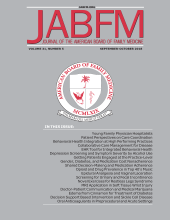Abstract
Background: Despite the current evidence of preventive screening effectiveness, rates of breast, cervical, and colorectal cancer in the United States fall below national targets. We evaluated the efficacy and feasibility of combining practice facilitation and academic detailing quality improvement (QI) strategies to help primary care practices increase breast, cervical, and colorectal cancer screening among patients.
Methods: Practices received a 1-hour academic detailing session addressing current cancer screening guidelines and best practices, followed by 6 months of practice facilitation to implement evidence-based interventions aimed at increasing patient screening. One-way repeated measures analysis of variance compared screening rates before and after the intervention, provider surveys, and TRANSLATE model scores. Qualitative data were gathered via participant focus groups and interviews.
Results: Twenty-three practices enrolled in the project: 4 federally qualified health centers, 10 practices affiliated with larger health systems, 4 physician-owned practices, 4 university hospital clinics, and 1 nonprofit clinic. Average screening rates for breast cancer increased by 13% (P = .001), and rates for colorectal cancer increased by 5.6% (P = .001). Practices implemented a mix of electronic health record data cleaning workflows, provider audits and feedback, reminder systems streamlining, and patient education and outreach interventions. Practice facilitators assisted practices in tailoring interventions to practice-specific priorities and constraints and in connecting with community resources. Practices with resource constraints benefited from the engagement of all levels of staff in the quality improvement processes and from team-based adaptations to office workflows and policies. Many practices aligned quality improvement interventions in this project with patient-centered medical home and other regulatory reporting targets.
Conclusions: Combining practice facilitation and academic detailing is 1 method through which primary care practices can achieve systems-level changes to better manage patient population health.







